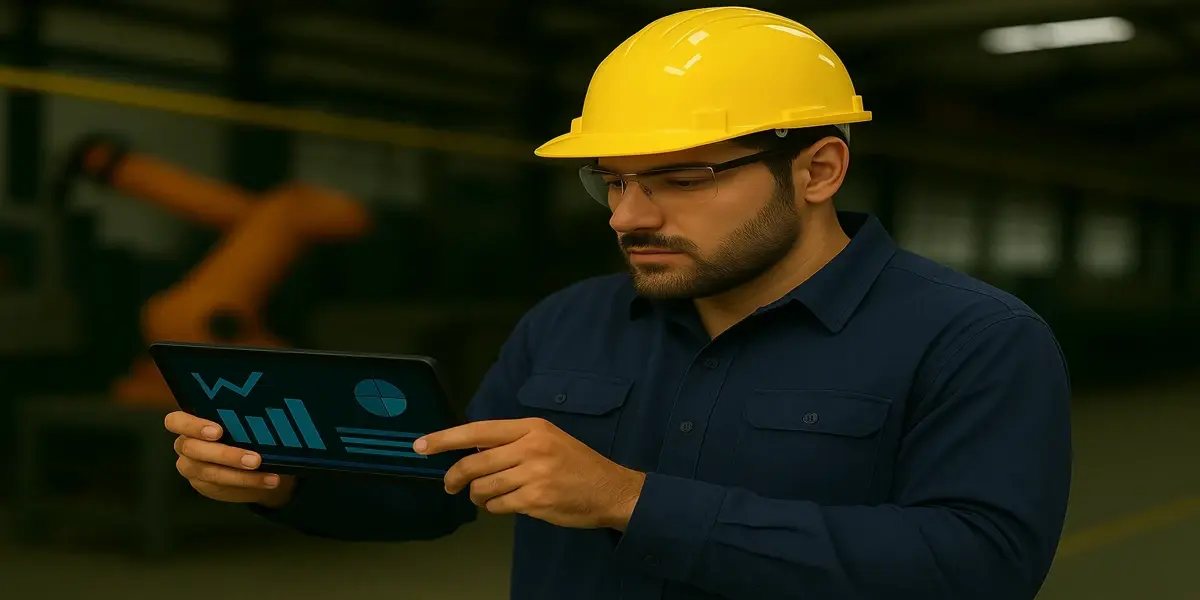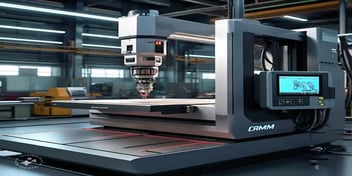

Introduction
In the era of Industry 4.0, the manufacturing landscape is undergoing a profound transformation. The integration of digital technologies, artificial intelligence (AI), automation, and data analytics is redefining how humans and machines collaborate. Facing global competition, supply chain volatility, and a skilled labor gap, manufacturers must find ways to maximize productivity and agility.
At the heart of this transformation lies connected worker technology, a digital ecosystem that bridges the gap between people, machines, and data. According to McKinsey (2024), companies adopting connected worker systems experience productivity gains of up to 30% and reduce unplanned downtime by 25%. These technologies empower operators with real-time insights, guided workflows, and digital collaboration tools that increase responsiveness and safety on the shop floor.
This article explores how connected worker technology enhances efficiency, fosters a data-driven culture, and positions organizations for long-term success in the smart manufacturing era.
1. Real-Time Data Access: Turning Information into Action
Traditional production systems often rely on delayed reports, manual entries, or fragmented spreadsheets. These lags lead to inefficiencies, limiting operators’ ability to react quickly to changes in production conditions. Connected worker platforms solve this issue by providing real-time visibility into every machine, process, and workflow.
Operators equipped with mobile devices, wearables, or digital dashboards can monitor key performance indicators (KPIs), view live production data, and receive alerts when parameters deviate from optimal ranges. As Deloitte Insights (2024) highlights, real-time data integration enables 20 to 25% faster issue resolution and improves decision-making accuracy across departments.
By turning raw data into actionable insights, connected worker solutions eliminate blind spots and ensure that decisions are based on live, accurate information boosting both productivity and quality.
2. Streamlined Communication Across the Shop Floor
Communication breakdowns remain one of the most persistent barriers to efficiency in manufacturing. Disconnected systems and manual reporting slow down collaboration between teams. Connected worker technologies close this gap through integrated communication platforms that link employees, machines, and management in real time.
From instant notifications on maintenance tasks to updates on production schedules, every stakeholder has immediate access to relevant information. Operators can report anomalies, share visual evidence through tablets, or request assistance without leaving their station. This transparency fosters collaboration and accountability.
As observed by PwC (2023), companies that adopt digital collaboration tools report up to a 35% improvement in cross-departmental efficiency. Seamless communication not only enhances coordination but also contributes to safer, more agile operations.
3. Guided Workflows and Task Prioritization
Connected worker platforms leverage AI-driven logic and predictive analytics to dynamically prioritize tasks based on workload, resource availability, and production goals. Workers receive step-by-step guidance through digital work instructions or augmented reality (AR) interfaces that reduce uncertainty and accelerate execution.
For instance, when a production line experiences a delay, the system automatically reprioritizes tasks, sending operators directly to the most critical points. This data-driven task allocation eliminates guesswork and supports faster recovery from disruptions.
According to the World Economic Forum (2024), such intelligent task management can improve overall equipment effectiveness (OEE) by up to 15%. The result is a more balanced workload distribution, greater throughput, and reduced human error.
4. Predictive Maintenance and Reduced Downtime
Unplanned downtime is among the most costly inefficiencies in industrial production. A single machine failure can disrupt entire workflows and cause significant financial losses. Studies by PwC (2023) indicate that downtime can represent as much as 20% of total production costs.
Connected worker technologies address this challenge through predictive maintenance systems powered by IoT sensors and AI analytics. Machines continuously transmit operational data, which algorithms analyze to detect anomalies, wear, or early failure signs. When issues arise, the system alerts operators to perform maintenance at the optimal time before breakdowns occur.
This proactive approach not only increases uptime but also extends equipment lifespan and reduces maintenance costs. Over time, predictive maintenance becomes a cornerstone of operational resilience and cost control.
5. Enhanced Skill Utilization and Workforce Empowerment
In today’s competitive manufacturing environment, skilled labor is one of the most valuable assets. Connected worker solutions enable employees to focus on high-value activities that require expertise, problem-solving, and creativity, while automating repetitive administrative tasks.
By providing standardized digital instructions, training modules, and safety protocols, connected worker platforms shorten the learning curve for new employees and reduce dependency on paper-based documentation. This knowledge-sharing approach democratizes expertise and helps bridge generational skill gaps in the workforce.
Research from the World Economic Forum (2024) shows that companies implementing connected workforce strategies report higher employee satisfaction and a 20% reduction in training time. Empowered workers feel more confident, engaged, and aligned with organizational goals.
6. Smarter Workflow Coordination Across Departments
Manufacturing operations involve intricate coordination among production, maintenance, supply chain, and quality control teams. Connected worker systems integrate these departments within a single digital framework to ensure alignment across every stage of production.
When an issue arises such as a delay in raw material delivery or a quality deviation the system automatically updates production schedules, reallocates resources, and notifies relevant teams. This cross-functional coordination minimizes downtime and prevents production bottlenecks.
According to BCG (2024), digitally synchronized workflows improve on-time delivery rates by up to 18% and reduce interdepartmental delays by 25%. The connected enterprise thus becomes more agile, capable of adapting to fluctuations in demand and supply.
7. The Role of AI and Analytics in Connected Work
Artificial intelligence and advanced analytics play a pivotal role in amplifying the value of connected worker technology. AI systems can process massive amounts of sensor and human-generated data to detect inefficiencies, forecast maintenance needs, and even predict safety risks before they occur.
Machine learning algorithms can recommend optimal staffing levels, sequence production orders, or optimize material handling routes based on real-time performance data. According to McKinsey (2024), manufacturers that integrate AI-driven analytics into connected worker ecosystems can reduce process variability by 20–30% and improve overall productivity by up to 25%.
By connecting human intelligence with digital foresight, AI creates a symbiotic relationship between workers and machines enhancing precision, safety, and innovation across the factory floor.
8. Data-Driven Decision Making and Continuous Improvement
Every connected task, machine status, and operator action generates data that can be transformed into performance insights. These metrics allow managers to track KPIs such as cycle time, OEE, energy usage, and first-pass yield.
By analyzing trends and patterns, leaders can identify bottlenecks, implement targeted improvements, and measure the impact of strategic initiatives. Over time, this fosters a culture of continuous improvement, where decisions are based on evidence rather than intuition.
As Deloitte Insights (2024) emphasizes, manufacturers adopting data-driven management frameworks achieve up to 40% faster improvement cycles compared to traditional approaches. Continuous learning becomes an integral part of the organization’s DNA.
9. Human-Machine Collaboration: The New Frontier of Productivity
The future of manufacturing lies in collaboration between human expertise and machine intelligence. Rather than replacing workers, technology enhances their decision-making capabilities and operational performance.
Augmented reality (AR) and mixed-reality tools can display 3D instructions or visual alerts directly within the operator’s field of view. AI assistants provide real-time recommendations during complex procedures. This seamless interaction reduces cognitive load and boosts safety.
Boston Consulting Group (2024) refers to this transformation as the “augmented workforce” paradigm where humans remain at the center, supported by technology that amplifies their capabilities. This synergy leads to higher accuracy, lower defect rates, and greater job satisfaction.
Conclusion: Bridging People, Machines, and Data
Connected worker technology has evolved from a niche innovation to a strategic pillar of digital transformation in manufacturing. By linking people, machines, and data into a unified ecosystem, it enhances productivity, safety, and adaptability across the enterprise.
From predictive maintenance and guided workflows to AI-powered analytics and cross-departmental coordination, the benefits of connected work are both measurable and transformative. Organizations embracing this model are redefining operational excellence while empowering their workforce for the future.
JITbase, as part of this industrial evolution, exemplifies how connected worker solutions can merge digital intelligence with human skill. http://www.jitbase.com/connect-your-machines-for-free-v2. Through real-time guidance, data-driven decision support, and seamless connectivity, JITbase helps manufacturers unlock measurable productivity gains while fostering a safer, smarter, and more resilient workplace.




